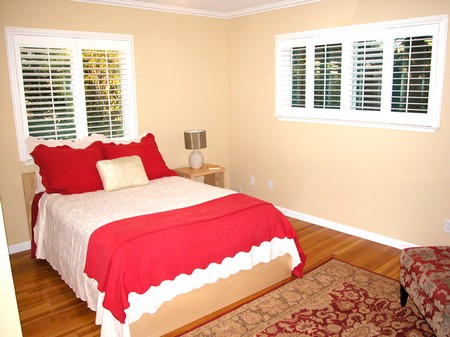Changing the colour of a room can alter both the size and feel of the room completely. When choosing a new colour, the decision should never be completely arbitrary. Imagine your home as a whole: try and let colour link the rooms and unify the house. By using the same carpet throughout or the same wall colour you can make your home look larger.
Colour and light
In a subdued northern light, such as found in Britain, soft colours are often the most successful. In contrast vivid colours work wonderfully in the brilliant southern sun.
When choosing new colours, study each room carefully. Never rush into painting a dark room a light colour in an attempt to cheer it up: dark rooms can be most effective and very cosy.

Colour and light are closely related. A room which faces north should have a warm colour scheme: you can afford to use rich deep yellows, pinks and browns. A sunny room can take pale, cool shades or harder colours, such as greys, lilacs and blues. It does not mean that you have to have different coloured carpets throughout your home: a neutral colour suits both warm and cool colours, with rugs added for extra colour and interest.
Colour and size
Colour can be used to change the shape and proportions of a room. Light colours will give you a feeling of spaciousness; dark, rich colours a feeling of warmth and cosiness – especially useful in a large room.
Low ceilings can be made to appear higher if the ceiling is painted a lighter colour than the walls. If you want to bring a ceiling height down, add a picture rail and paint the ceiling down to the picture rail a darker colour than the rest of the walls. By painting alcoves recesses a dark colour they can be made to disappear, which will highlight any fireplace or wall between them. By making carpet, walls and curtains the same pale colour and by keeping strong colours in the centre of the room, a small room can appear more spacious. Otherwise it is almost always better to have the floor darker than the walls and ceilings as it will give solidity to a room – an effect which can easily be achieved by throwing a large rug over a pale carpet.
Various colour schemes
Monochromatic schemes use shades of one colour only. Monotony is avoided by varying the values and intensities of the colour. Further interest is added by-contrasting texture, patterns and materials (china, glass, wood etc) within the one-colour plan. The addition of black or white to the scheme is sophisticated and subtle.
Related or harmonious decorating schemes use three colours adjacent to each other on the colour wheel, all of which share a common base colour. One such scheme might use yellow with yellow/orange and orange; another yellow/green, yellow and yellow/ orange; another blue/green, blue and blue/violet. To avoid dullness, use colours of different values and intensities.
Contrasting or complementary schemes use opposite colours such as orange and blue, yellow and violet, red and green. Each scheme therefore uses a cool and a warm colour which are intensified by being used together. The colours used are rarely as bright as those shown on the colour wheel, but tints and shades of these colours.
Primary schemes use several, or just one, primary colour with white. The primary colours used need not be pure. Black and white used with yellow/green with highlights of blue/violet can look striking. A primarily white room used with red/violet, blue/green and yellow/orange will look larger, the primary colours forcing the room apart.